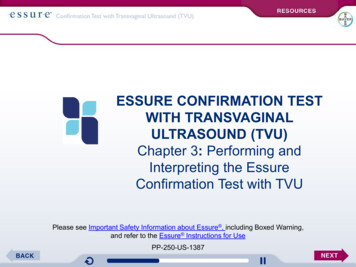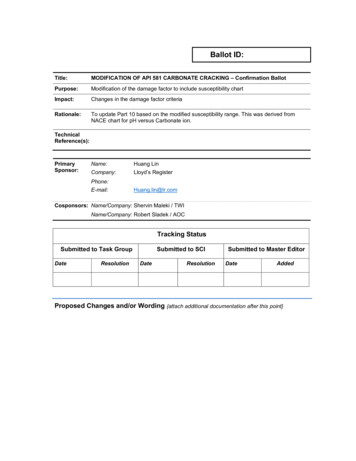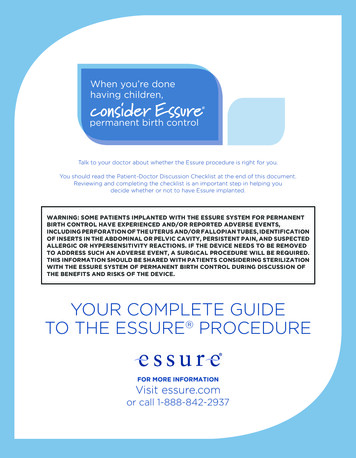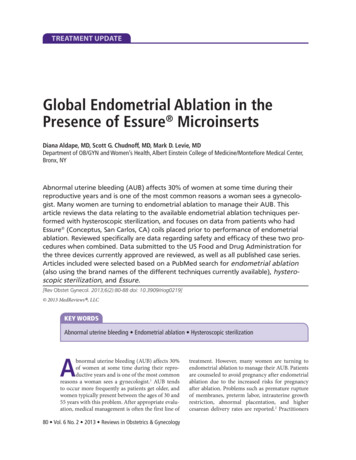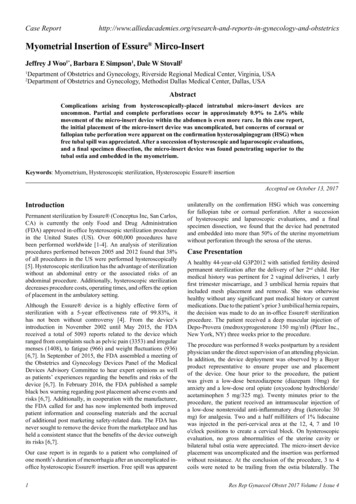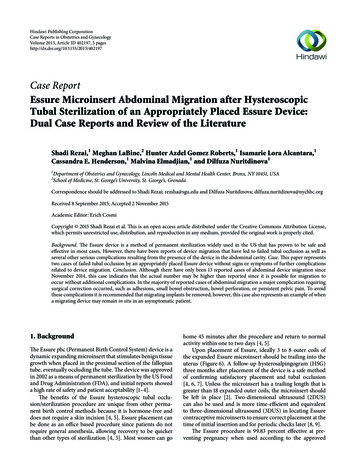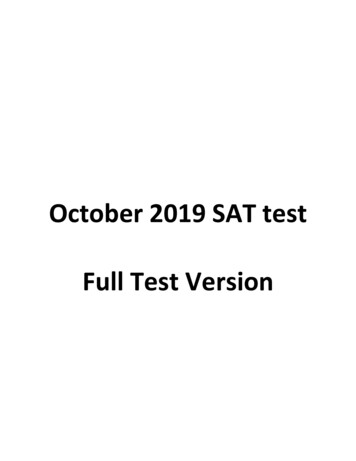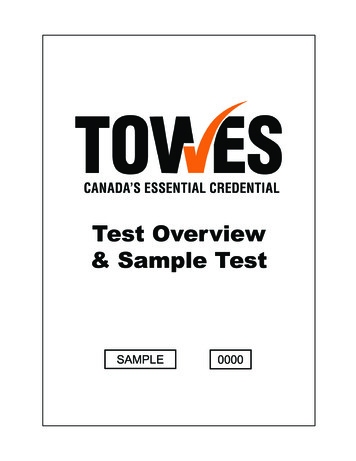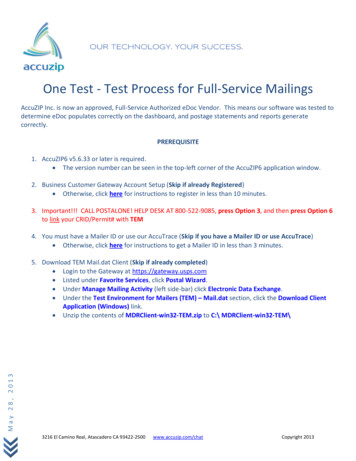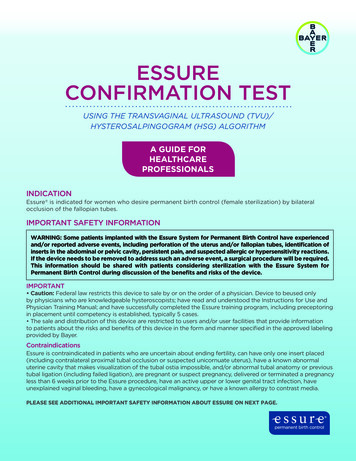
Transcription
ESSURECONFIRMATION TESTUSING THE TRANSVAGINAL ULTRASOUND (TVU)/HYSTEROSALPINGOGRAM (HSG) ALGORITHMA GUIDE FORHEALTHCAREPROFESSIONALSINDICATIONEssure is indicated for women who desire permanent birth control (female sterilization) by bilateralocclusion of the fallopian tubes.IMPORTANT SAFETY INFORMATIONWARNING: Some patients implanted with the Essure System for Permanent Birth Control have experiencedand/or reported adverse events, including perforation of the uterus and/or fallopian tubes, identification ofinserts in the abdominal or pelvic cavity, persistent pain, and suspected allergic or hypersensitivity reactions.If the device needs to be removed to address such an adverse event, a surgical procedure will be required.This information should be shared with patients considering sterilization with the Essure System forPermanent Birth Control during discussion of the benefits and risks of the device.IMPORTANT Caution: Federal law restricts this device to sale by or on the order of a physician. Device to beused onlyby physicians who are knowledgeable hysteroscopists; have read and understood the Instructions for Use andPhysician Training Manual; and have successfully completed the Essure training program, including preceptoringin placement until competency is established, typically 5 cases. The sale and distribution of this device are restricted to users and/or user facilities that provide informationto patients about the risks and benefits of this device in the form and manner specified in the approved labelingprovided by Bayer.ContraindicationsEssure is contraindicated in patients who are uncertain about ending fertility, can have only one insert placed(including contralateral proximal tubal occlusion or suspected unicornuate uterus), have a known abnormaluterine cavity that makes visualization of the tubal ostia impossible, and/or abnormal tubal anatomy or previoustubal ligation (including failed ligation), are pregnant or suspect pregnancy, delivered or terminated a pregnancyless than 6 weeks prior to the Essure procedure, have an active upper or lower genital tract infection, haveunexplained vaginal bleeding, have a gynecological malignancy, or have a known allergy to contrast media.PLEASE SEE ADDITIONAL IMPORTANT SAFETY INFORMATION ABOUT ESSURE ON NEXT PAGE.
IMPORTANT SAFETY INFORMATION (cont’d)General Warnings T he Essure procedure should be considered irreversible. Pain (acute or persistent) of varying intensity and length of time may occur following Essure placement.This is also more likely to occur in individuals with a history of pain. If device removal is indicated, thiswill require surgery. Patients with known hypersensitivity to nickel, titanium, platinum, stainless steel, and PET (polyethyleneterephthalate) fiber or any of the components of the Essure system may experience an allergic reactionto the insert. In addition, some patients may develop an allergy to nickel or other components of theinsert following placement. Symptoms reported for this device that may be associated with an allergicreaction include hives, urticaria, rash, angioedema, facial edema and pruritis. Patients shouldbe counseled on the materials contained in the insert prior to the Essure procedure. Currently thereis no test that reliably predicts who may develop a hypersensitivity reaction to the materials containedin the insert. Patients on immunosuppressive therapy may experience delay or failure of the necessary tissuein-growth for tubal occlusion. For these patients, physicians must use the modified HSG as the EssureConfirmation Test. Transvaginal ultrasound (TVU) should not be used as the Essure Confirmation Test,as TVU cannot confirm tubal occlusion.Pregnancy Risk P regnancies including ectopic pregnancies have been reported among women who have undergonethe Essure procedure. The patient must use alternative contraception until a satisfactory Essure Confirmation Test isdocumented. If the Essure inserts are not properly placed or are not in a satisfactory location,then the patient should be advised to not rely on Essure and use alternative contraception Counsel the patient on the need for the Essure Confirmation Test, the options for the confirmationtest including their risks and benefits, and the possibility that the Essure Confirmation Test may beunsatisfactory. Effectiveness rates for the Essure procedure are based on patients who had bilateral placement anda satisfactory Essure Confirmation TestProcedure Warnings N ever attempt to advance Essure insert(s) against excessive resistance. If a perforation occurs or issuspected, do not continue procedure and monitor the patient for signs and symptoms of possiblecomplications related to perforation which may include unusual post-operative pain. To reduce the risk of hypervolemia, terminate procedure if distension fluid deficit exceeds 1500ccor total hysteroscopic procedure time exceeds 20 minutes. Excess fluid deficit may signal uterineor tubal perforation. If noted, discontinue procedure and evaluate patient for possible perforation. Do not attempt hysteroscopic Essure insert removal during the placement procedure unless 18 ormore trailing coils are seen inside the uterine cavity due to risk of a fractured insert, fallopian tubeperforation, or other injury. DO NOT perform the Essure procedure concomitantly with endometrial ablationMRI InformationThe Essure insert was determined to be MR-conditional according to the terminology specified in theAmerican Society for Testing and Materials (ASTM) International, Designation: F2503-05.Adverse EventsThe most common ( 10%) adverse events resulting from the placement procedure were cramping, pain,and nausea/vomiting. The most common adverse events ( 3%) in the first year of reliance were back pain,abdominal pain, and dyspareuniaThis product does not protect against HIV infection or other sexually transmitted diseases.Prescription OnlyPLEASE SEE THE IMPORTANT SAFETY INFORMATION, INCLUDING BOXED WARNING, ON PAGES 1 AND 2.2
TABLE OF CONTENTSPerforming the Essure Confirmation Test4Essure TVU/HSG Confirmation Test Algorithm4Using the Essure TVU/HSG Confirmation Test Algorithm5Essure Confirmation Test With TVUEssure Confirmation Test TVU Eligibility Checklist7Performing the Essure Confirmation Test With TVU8Documenting and Interpreting the Essure Confirmation Test With TVU8Evaluating Essure Confirmation Test With TVU Images8Essure Confirmation Test With Modified HSGPerforming the Essure Confirmation Test With Modified HSG15Radiographic Markers16Radiograph Imaging17Evaluating Essure Confirmation Test With Modified HSG Films Quality19Evaluating Insert Location20Evaluating Tubal Occlusion23Essure Confirmation Test With Modified HSG Checklist25Essure Confirmation Tests Coding InformationCoding Information for Essure Confirmation Tests26PLEASE SEE THE IMPORTANT SAFETY INFORMATION, INCLUDING BOXED WARNING, ON PAGES 1 AND 2.3
Performing the Essure Confirmation TestThe Essure Confirmation Test is an integral part of the Essure permanent birth control procedure.The test must show either bilateral satisfactory insert location (when using a transvaginal ultrasound(TVU)) or bilateral satisfactory insert location and occlusion (when using a modified hysterosalpingogram(modified HSG)) in the fallopian tubes before the patient can rely on Essure for contraception. A n Essure Confirmation Test should be performed 3 months after insert placement to evaluate insertretention and location The Essure Confirmation Tests (TVU* or modified HSG) should be performed only by an experiencedhealthcare provider, including gynecologist, ultrasonographer, and/or radiologist who knows how toperform the appropriate Essure Confirmation Test. Training and educational materials on the EssureConfirmation Test are available through Bayer. The Essure Confirmation Test may be performed with TVU or modified HSG as determined by the TVU/HSGConfirmation Test Algorithm.Essure TVU/HSG Confirmation Test AlgorithmBilateral Essure placementDetermine at placement if patient is an appropriatecandidate for the Essure Confirmation Test with TVU percriteria outlined on the TVU Eligibility Checklist (See page 7)NoYesEssure Confirmation Test withTVU at 3 months post-placementBoth inserts in optimalor satisfactory position(See TVU criteriaon page 11)YesOREssure Confirmation Test with modifiedHSG at 3 months post-placementNoPatient cannot rely onEssure for birth control andshould remain on alternativecontraception, and mustproceed to a ConfirmationTest with modified HSG B oth inserts in satisfactorylocation AND Bilateral tubal occlusion(See modified HSG checklist on page 25)YesNoPatient may rely on Essure for birthcontrol and discontinue alternativecontraception Patient cannot rely onEssure for birth controland should remain onalternative contraception* Healthcare providers who utilize the Essure Confirmation with TVU must completetraining administered by Bayer and documented by a certificate of completion. Proceed to clinicalmanagement per guidancein the Instructions for UsePLEASE SEE THE IMPORTANT SAFETY INFORMATION, INCLUDING BOXED WARNING, ON PAGES 1 AND 2.4
Using the Essure TVU/HSG Confirmation Test Algorithm W hen using the TVU/HSG Confirmation Test Algorithm, TVU may be performed as a first-line confirmationtest 3 months after a bilateral insert placement procedure if all of the following criteria are met:—Placement procedure was not difficult, including all of the following: No concern at the time of placement of possible perforation due to excessive force requiredfor insert delivery and/or a sudden loss of resistance No difficulty identifying the tubal ostia during placement due to anatomical variation ortechnical factors such as poor distention, suboptimal lighting, or endometrial debris Physician is certain about placement— Procedure time 15 minutes (scope in–scope out)—Placement with 1-8 trailing coils for each insert— No unusual post-operative pain, transient or persistent, or onset at some later time post-procedure,without any other identifiable cause P atients on active immunosuppressive therapy (eg, systemic corticosteroids or chemotherapy),may experience delay or failure of the necessary tissue in-growth needed for tubal occlusion.For these patients, physicians must use the modified HSG as the Essure Confirmation Test.TVU should not be used for confirmation, as this test cannot confirm tubal occlusion.Clinical trials were not conducted with patients undergoing immunosuppressive therapy. T rans-abdominal ultrasound cannot be substituted for TVU. If ultrasound is not indicated, patientmust proceed to a modified HSG to evaluate insert location and tubal occlusion. If ultrasound evaluationis equivocal or unsatisfactory, patient must proceed to a modified HSG to evaluate insert location andtubal occlusion P atient must use alternative contraception until a satisfactory Essure Confirmation Test is documented D iscuss the 2 methods used in the Essure Confirmation Test (TVU and modified HSG). Inform patientsof the differences between the methods, including benefits and risks (including possible increased risk ofpregnancy if TVU is the only confirmation method utilized)Remember that a modified HSG is always an acceptable first-line option for the Essure Confirmation Test.If TVU is performed and the results are equivocal or unsatisfactory, the patient cannot rely on Essure forbirth control and a modified HSG is require d to evaluate insert location and tubal occlusion. The patientmust also be instructed not to discontinue her alternative contraception.For additional information about Essure and the Essure Confirmation Test, refer to the Instructions forUse or contact your Bayer Sales Consultant.The TVU Eligibility Checklist on page 7 can be used to assess if the patient meets the criteria forconfirmation using TVU.Consider establishing a protocol in your office for scheduling Essure Confirmation Testappointments, calling with reminders, and tracking Essure Confirmation Test compliance.PLEASE SEE THE IMPORTANT SAFETY INFORMATION, INCLUDING BOXED WARNING, ON PAGES 1 AND 2.5
ESSURECONFIRMATION TESTWITH TVUHealthcare providers who utilize the Essure ConfirmationTest With TVU must complete training, which is administeredby Bayer and documented by a certificate of completion.For more information, ask your Bayer Sales Consultant orgo to the Medical Affairs Site in EssureMD.com.PLEASE SEE THE IMPORTANT SAFETY INFORMATION, INCLUDING BOXED WARNING, ON PAGES 1 AND 2.6
TVU Eligibility Checklist for the Essure Confirmation TestImmediately after Essure bilateral placement, complete the checklist below to help determine whetherthe patient is eligible for the Essure Confirmation Test with TVU (see TVU/HSG Confirmation Test Algorithmon pages 4-5). The Essure Confirmation Test should be performed at 3 months post-placement.TVU EligibilityDescribe Insertion ProcedureAGREEDISAGREEYESNO here was no concern at the time of placement of possible perforation due toTexcessive force and/or sudden loss of resistance. here was no difficulty in identifying the tubal ostia due to anatomical variation orTtechnical factors (eg, poor distension, suboptimal lighting, or endometrial debris). You are certain about bilateral placement. The procedure time (scope in–scope out) was 15 minutes. Placement occurred with 1-8 trailing coils for both left and right inserts. here was no unusual post-operative pain, transient or persistent, or onset atTsome later time post-procedure, without any other identifiable cause. he patient was not on active immunosuppressive therapy (eg, systemicTcorticosteroids or chemotherapy).Final DeterminationI f you answered “Disagree” to any of the statements above, the patient is noteligible for TVU and a modified HSG is required to evaluate insert location andtubal occlusion. Transabdominal ultrasound cannot be substituted for TVU. Does the patient meet the above criteria for the option of an EssureConfirmation Test with TVU?** Refer to the TVU/HSG algorithm included on pages 4-5 for the full set of criteria and to determine whether the patient is a candidate for an EssureConfirmation Test using TVU. C ounsel the patient to remain on alternative contraception until a satisfactory Essure ConfirmationTest is documented D iscuss the 2 methods used in the Essure Confirmation Test (TVU and modified HSG) I nform patients of the differences between the methods, including benefits and risks includingpossible increased risk of pregnancy if TVU is the only confirmation method usedRemember to include a procedural note in the patient’s chart indicating whethershe is an appropriate candidate for the Essure Confirmation Test with TVU, or if shemust proceed directly to a modified HSG. A modified HSG is always an acceptablefirst-line option for the Essure Confirmation Test. If TVU is performed and the resultsare equivocal or unsatisfactory, the patient cannot rely on Essure for birth controland a modified HSG is required to evaluate insert location and tubal occlusion.The patient must also be instructed not to discontinue her alternative contraception.PLEASE SEE THE IMPORTANT SAFETY INFORMATION, INCLUDING BOXED WARNING, ON PAGES 1 AND 2.7
Performing the Essure Confirmation Test With TVUBefore proceeding with the Essure Confirmation Test with TVU at 3 months, confirm that the patientmeets the criteria for the option of an Essure Confirmation Test with TVU (see TVU/HSG ConfirmationTest Algorithm on pages 4-5). If TVU is not indicated, a modified HSG is required to evaluate insertlocation and tubal occlusion.Performing the Essure Confirmation Test With TVUAs the treating physician, it is your responsibility to confirm the results from the TVU Confirmation Testreport. Based on the clinical trial protocol, the TVU Confirmation Test has 3 components: orientation,identification, and location. A minimum of 3 required images (TVU scout image, image of left insert,image of right insert) must be obtained and retained for documentation of the TVU Confirmation Test.It is also useful to obtain real-time video, including the 3 required images, if technically possible.Orientation (assessment of uterine orientation)Midline sagittal viewIndicate the uterine orientation (check one):YESAntevertedMidplaneRetrovertedCan you confirm that the linear axis of either insert was not visualized in this view?If no, please describe below.If the linear axis of an insert is visualized in the uterine cavity, proximal placement should be suspected. If the linearaxis is visualized in the fundal myometrium, fundal perforation should be suspected. Visualization of the proximalend of 1 or both inserts in cross-section may indicate trailing coils in the uterine cavity.Identification (visualization of a portion of both inserts simultaneously)Transverse or oblique transverse viewFigure 1. TVU scout imageWas a portion of both inserts identifiedwithin the cornua or interstitial portion ofthe tubes?Was a TVU scout image captured todocument the presence of 2 inserts?Can you clearly see that the inserts arenot in contact with each other, withthe linear axes of the inserts relativelysymmetric and on opposite sides of theuterus?If 0 or only 1 insert is identified, expulsion orperforation should be suspected.If the inserts are in contact with each other, proximallocation or expulsion is suspected.PLEASE SEE THE IMPORTANT SAFETY INFORMATION, INCLUDING BOXED WARNING, ON PAGES 1 AND 2.8NO
Performing the Essure Confirmation Test With TVU (continued)Location (location of the right and left inserts)Transverse or oblique transverse viewYESNOFigure 2. Right insert imageWas the linear axis of the right insertidentified as a contiguous echogenicstructure?Was an image of the linear axis of theright insert captured for documentation?Figure 3. Left insert imageWas the linear axis of the left insertidentified as a contiguous echogenicstructure?Was an image of the linear axis of the leftinsert captured for documentation?Note the positions of the right and left insertsin the cornua and the relationships with theendometrium and the serosal utero-tubaljunction (SUTJ).PLEASE SEE THE IMPORTANT SAFETY INFORMATION, INCLUDING BOXED WARNING, ON PAGES 1 AND 2.9
Performing the Essure Confirmation Test With TVU (continued)Classification (classification of right and left inserts location)Right insert: Please indicate the category of the right insert location (check one):OptimalSatisfactoryUnsatisfactoryEquivocalIf unsatisfactory, please indicate the category (check dLeft insert: Please indicate the category of the left insert location (check one):OptimalSatisfactoryUnsatisfactoryEquivocalIf unsatisfactory, please indicate the category (check dConfirmationYESIf you answered “No” to any of the questions above (pages 8-9), or if the TVUresults were equivocal or unsatisfactory, inform the patient that she cannot rely onEssure for birth control and must remain on alternative contraception, and an EssureConfirmation Test with modified HSG is required to evaluate insert location and tubalocclusion.Can the patient rely on Essure for birth control?Does the patient need to proceed to an Essure Confirmation Testwith modified HSG?PLEASE SEE THE IMPORTANT SAFETY INFORMATION, INCLUDING BOXED WARNING, ON PAGES 1 AND 2.10NO
Classification of TVU LocationsFigure 4Satisfactory locationThe proximal end of the insert is distal to the endometrium;however, the linear axis is within the myometrium in thecornua (interstitial portion of the fallopian tube) and can bevisualized at or crossing the SUTJ. The portion of the insertlocated in the fallopian tube may or may not be visualized.The linear axis of the insert must be visualized to confirmit is not coiled or elongated.Figure 5Optimal locationThe proximal end of the
The Essure Confirmation Test is an integral part of the Essure permanent birth control procedure. The test must show either bilateral satisfact
